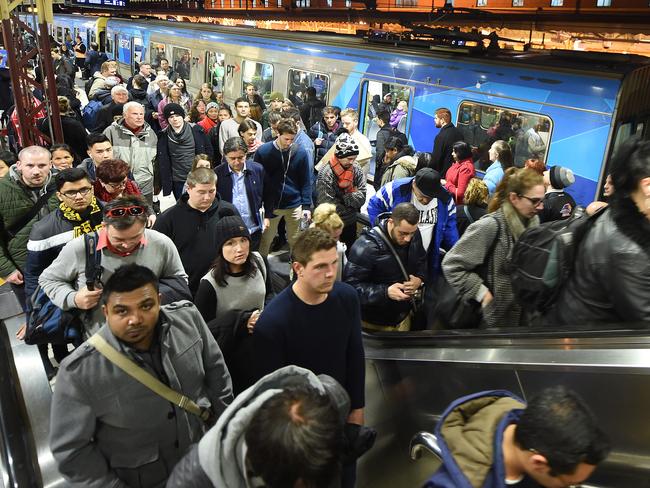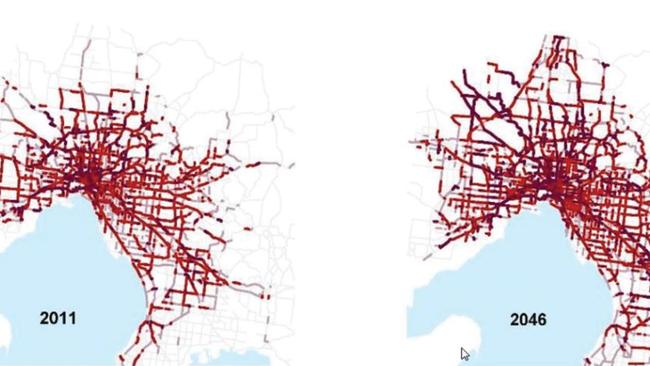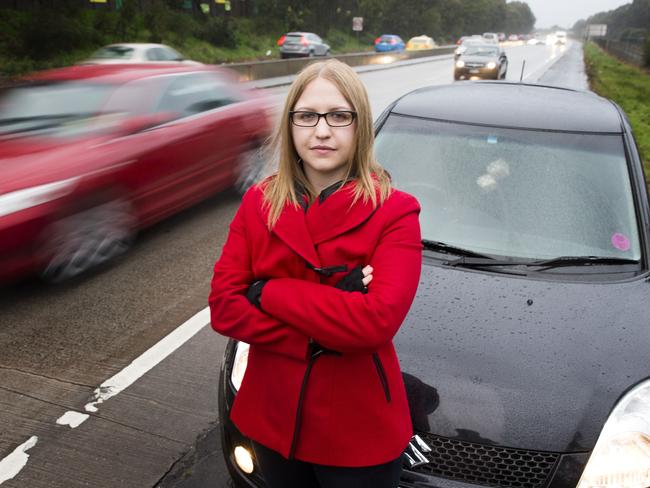Melbourne traffic congestion: Peak traffic now lasts 3.75 hours dire report reveals
MELBOURNE is facing unprecedented traffic and train congestion, with the afternoon peak now lasting three and a quarter hours. SURVEY: How can we fix this?

VIC News
Don't miss out on the headlines from VIC News. Followed categories will be added to My News.
MELBOURNE is facing unprecedented traffic congestion with the afternoon peak now lasting three and a quarter hours.
A report commissioned by Infrastructure Victoria paints a dire picture for car and train commuters with crippling congestion already occurring in the inner city networks which is predicted to spread to outer suburban roads and metropolitan train lines in the coming years.
The Herald Sun can reveal the morning peak now lasts a record 2.7 hours, 3.2 hours in the afternoon and out of peak delays have increased by 30 per cent.
Train commutes are also looking grim with some lines to begin overflowing in the 2030s, despite the introduction of the $11 billion Metro Rail Project.
EDITORIAL: Travel key to livability

The dire outlook is prompting the investigation of potential fixes including:
— Melbourne Airport Rail
— North-East Link between M80 and eastern freeway
— City Loop reconfiguration
— Buying high capacity 10-car trains
— Extending tram network
— Bicycle highways and bus lanes
— Road fees and tolls to manage demand
— Introducing driverless cars and trucks


“In the next 30 years, the bulk of Victoria’s population growth is expected to occur in
the Melbourne region, placing significant pressure on the existing transport network,’’ the capability report warned.
``The outer network is nearing capacity such that performance impacts are beginning to be experienced, the inner network has been at capacity for sometime.’’
Experts and transport advocates say a commitment to further infrastructure projects is the first step to dealing with the crush, and projects such as the Melbourne Airport Rail Link, Northeast road link should be locked in.
Roads and Acting Minister for Public Transport Luke Donnellan said the government was aware of the looming challenge.
“Victoria is growing faster than any state, and we’re building for that growth by investing in transport infrastructure across the board.’’
HAVE YOUR SAY IN OUR SURVEY NOW
However, Opposition roads spokesman Ryan Smith warned current plans were “woefully inadequate” for a state growing at 100,000 people a year.
“This report clearly shows that Daniel Andrews was wrong to spend $1.1 billion to scrap the East West Link,’’ he said.
According to RACV’s policy manager, Brian Negus, growth areas in the west, north, and southeast of Melbourne were all contributing to congestion and new projects would be needed in the long term including an outer ring road taking in Werribee and Thomastown.
In the short term he said the mooted northeast link, joining the Ring Road at Greensborough to EastLink must be a bipartisan project.
Mr Negus said the Melbourne Airport Rail Link — which has bipartisan support in principle -should be planned as a stand-alone service before the Melbourne Metro tunnel opens.
Public Transport Users Association spokesman Daniel Bowen said politicians needed to stay “ahead of the game”.
``You can’t just pull new trains out of your pocket. The key is for politicians to accept the recommendations of Infrastructure Victoria rather than waiting.’’
He called for a focus on train lines that would not directly benefit from the Melbourne Metro tunnel and more co-ordination with trams and buses.
Infrastructure Victoria CEO Michel Masson said the documents gave “a holistic view of all existing infrastructure” and would be key to planning Melbourne’s future.
Revelations the entire transport network is in facing challenges comes after VicRoads CEO John Merritt called on commuters to use more integrated forms of transport last year: including motorists riding a bike or getting a new job to avoid gridlock.
His call came after data showed nine of Melbourne’s major thoroughfares including the Eastern Freeway, the Monash Freeway and the West Gate Freeway were nearing capacity and were expected to be clogged before 2031.
Trains lines capacity forecast
Sunbury — Late 2020s
Dandenong — After 2030
Werribee — Mid 2030s
Craigieburn — Mid 2030s
Upfield — 2046
Frankston — 2046
Sandringham — 2046
South Morang Line — Unknown
*projections are based on completion of the Melbourne Metropolitan Rail Project.
Roads
Peak AM: 6.45am to 9:15am
Delays AM: Up 25 per cent
Peak PM: 3pm to 6.15pm
PM Delays: Up 20 per cent
Off peak delays: Up 30 per cent
Metro traffic Up 20 per cent
Travel time: Up 1.4 miss per 10km
Challenges
Overcrowding on V/Line increasing
Declining road conditions on urban roads
Average road travel speed decreased 4km per hour
Public Transport fares growing faster than CPI
Clogged from all directions

Melbourne commuters say the future looks grim with roads and trains already clogged.
Nick Campione, 53 commutes daily from Werribee and said catching the train had become a battle for many travellers as carriages filled up faster than ever before.
“There was nothing out here in the 70s,’’ he said.
“By 2020 the train is going to look like something in India with people hanging off the outside.
TYou get to Hoppers Crossing and there is sitting room but at Williams Landing it is standing room only.
“They (the government) just didn’t know the population was going to grow so much.’’
Mr Campione says trains are often stopped outside of stations waiting for other services to pass through and said more carriages could not be the only fix for the problem.
He also warned housing in the south west had exploded with more estates on the way.
He feared the development would place extra pressure with scores of new passengers in the coming years.
Things are not much better across the city for Melanie Petz, 24, who says traffic can be a nightmare on her drive to work in Croydon even before peak hour hits.
“To get to the Eastern Freeway is a real challenge, especially on Bulleen Rd” Ms Petz said.
“I leave as close to 6.30am as possible, but if I leave as little as half an hour later, there’s just no way I would make it to work on time.
“I hate being caught in traffic; it raises everyone’s stress levels, and it makes everyone impatient drivers, and people become dangerous, darting in and out of traffic, cutting you off, or merging on to you without looking.
“One of the most frustrating things in the afternoons in the Ring Road, when the three lanes merge into two, it’s congestion city, and traffic banks all the way up to Dalton Rd.”
Both have backed quick action from the State Government and warned things are only going to get worse.
— with Therese Alloui


